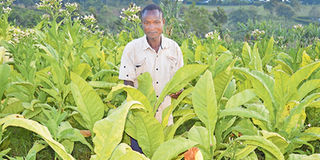Allure of big tobacco cash tempts farmers back to the cash crop

Daniel Esese in his tobacco farm in Kuria East, Migori County. To grow the crop, he plants certified seeds he gets from the buyer, East African Tobacco, first in the seedbed, where they take a month to be ready for transplanting. PHOTO | THOMAS MATIKO | NMG
What you need to know:
- A majority of them opted to grow sweet potatoes and sorghum on large-scale in the quest to earn from the soil.
- With odds stuck against farmers, a number of them like Esese are returning to tobacco after new buyers — Platinum Tobacco and East Africa Tobacco — emerged. Mastermind also buys tobacco in the area.
- Generally, farmers grow two types of tobacco namely Flue-STV or Fire-DSP, which are categorised depending on how they are dried/cured after harvest.
- The company also supplies them with fertiliser, fire boxes and pesticides. While seeds are free, farmers pay for the rest of the inputs from their earnings.
Daniel Esese stands on his farm in Getongoroma, Kuria East, Migori County, surrounded by a leafy green crop about a metre high.
Esese smiles as he picks some of the leaves and places them in a basket. Three years ago, anyone visiting the area could not see such activities because most farmers had abandoned growing the crop — tobacco — due to lack of steady market.
But farmers are now back to tobacco farming after the hiatus, with many once again reaping from the crop as they had done decades ago.
“We stopped growing the crop after the biggest tobacco leaf buyer Alliance One closed shop in Migori County and relocated to Tanzania,” recounts Esese, adding that many farmers were left stranded with the crop making some uproot it.
A majority of them opted to grow sweet potatoes and sorghum on large-scale in the quest to earn from the soil.
“But the returns from sweet potatoes were not impressive since we also lacked proper market. Brokers would come from Nairobi and buy an extended 90kg sack at Sh500 and go and sell at seven times more,” says Esese, adding that a promise by the county government to set up a processing plant in the area has not materialised.
With odds stuck against farmers, a number of them like Esese are returning to tobacco after new buyers — Platinum Tobacco and East Africa Tobacco — emerged. Mastermind also buys tobacco in the area.
“I would rather grow tobacco because it pays more than sweet potatoes. With tobacco, I am assured of making even Sh300,000 from my two acres when prices are good but the much I can make from potatoes is Sh30,000.”
Generally, farmers grow two types of tobacco namely Flue-STV or Fire-DSP, which are categorised depending on how they are dried/cured after harvest.
TOP GRADE OF THE VARIETY
Fire is cured in the kiln using smoke while Flue heat. The curing process takes a week and the goal is to have the leaves dried to attain black or brown colour which forms the top grades. Esese, who has grown tobacco for about two years, farms the Flue variety.
To grow the crop, he plants certified seeds he gets from the buyer, East African Tobacco, first in the seedbed, where they take a month to be ready for transplanting.
The company also supplies them with fertiliser, fire boxes and pesticides. While seeds are free, farmers pay for the rest of the inputs from their earnings.
“For good harvest, you must plant the crop with NPK fertiliser then top dress. Harvesting starts after three months and continues for about four months,” he explains.
He sells the top grade of the variety at Sh222 per kilo with the second fetching Sh200.
For Fire, the top grade goes for Sh184 per kilo and second Sh163. There are generally 12 types of grades in each type of tobacco. The least grade sells at Sh36 per kilo.
George Nyamwitanga, an agronomist in Kuria East, says the crop is mainly affected by tobacco mosaic and Leaf curling.
“These are viral diseases which cannot be eliminated once they attack the crop. However, they are controlled by spraying the plant during early stages.”
Common tobacco pests are archids, which eat up the stem of the plant and caterpillars that feed on the leaves.
According to Nyamwitanga, the two types of tobacco grown in the region, cannot be cured using solar.
“Ugandans grow the variety that is cured by solar and is known as Bally. In Kenya, some farmers in parts of eastern also farm the solar-cured crop,” he says.




